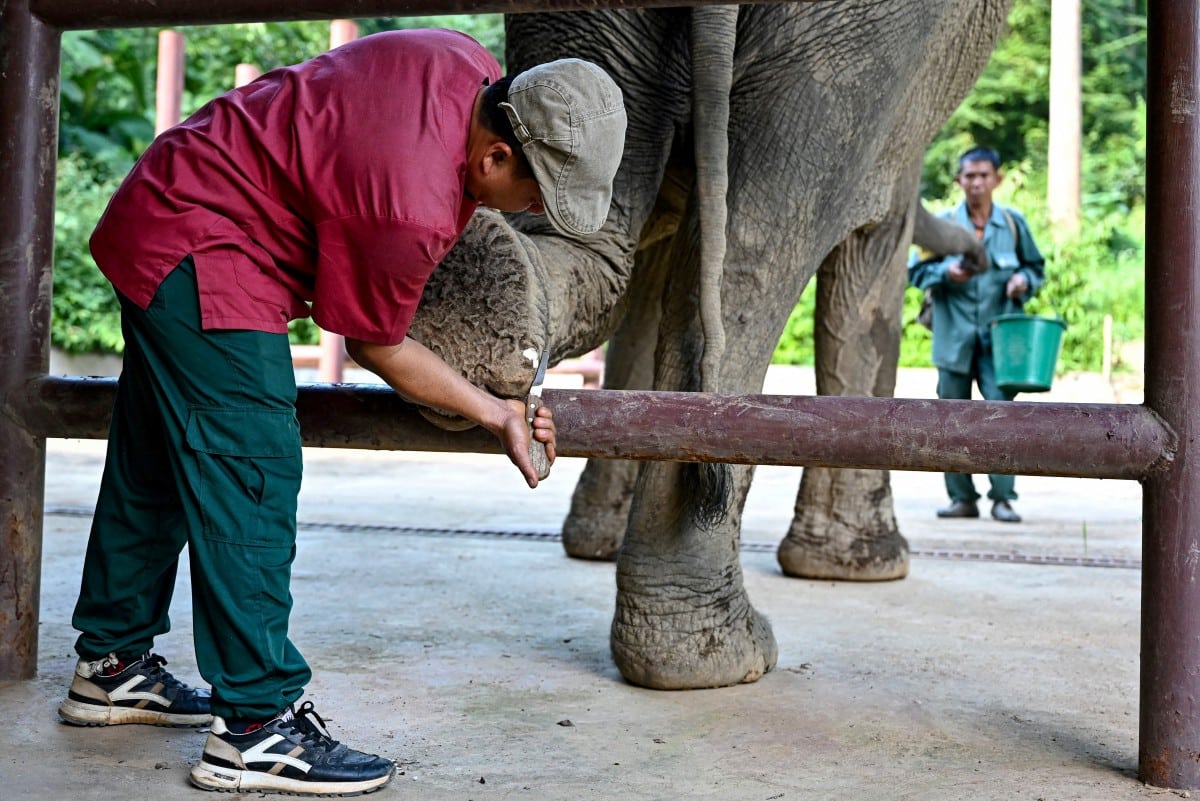
This photograph taken on October 13, 2024 exhibits veterinary assistant and mahout supervisor Sounthone Phitsamone chopping the nails of an elephant on the Elephant Conservation Middle (ECC) in Sainyabuli province in Laos. Agence France-Presse
SAINYABULI, Laos — Sluggish and silent, former logging elephant Mae Khoun Nung emerges from a forest in northern Laos and follows her information to an animal hospital for a check-up.
As soon as considerable within the forests of Laos, Asian elephants like her have been decimated by habitat destruction, grueling labour within the logging business, poaching and scarce breeding alternatives.
However conservationists are hoping DNA evaluation of elephants’ dung will assist them monitor each captive and wild tuskers, to allow them to safe a wholesome genetic pool and craft an efficient breeding plan to guard the species.
READ: LOOK: Miss Universe Laos’ nationwide costume honors elephants
Laos — as soon as proudly referred to as “Lane Xang” or “Land of a Million Elephants” — has between 500 and 1,000 of the animals left, simply one-third of the inhabitants 20 years in the past, in response to conservation group WWF-Laos.
Article continues after this commercial
Round 10 elephants die annually for each one to 2 born, a charge that places the animals prone to dying out fully within the Southeast Asian nation.
Article continues after this commercial
“The last word purpose can be to safe a wholesome inhabitants of captive elephants to behave as a genetic reservoir if the wild inhabitants collapses,” wildlife biologist Anabel Lopez Perez informed AFP at her laboratory on the Elephant Conservation Middle (ECC) in Sainyabuli province.
As soon as researchers study what number of particular person elephants are within the nation — by testing DNA-containing cells in dung — Perez mentioned a breeding plan will assist them handle genetic variety, stop inbreeding and produce more healthy calves that could possibly be launched into the wild to bolster the declining inhabitants.
Elephant hospital
On the hospital of the ECC, which shelters 28 elephants at its 500-hectare (1,200-acre) sanctuary, Mae Khoun Nung backs right into a tall metallic scaffolding construction, designed specifically for check-ups on the animals.
Sounthone Phitsamone, who manages the centre’s elephant keepers and acts as an assistant vet, faucets the animal’s leg and she or he calmly raises her foot for him to test.
READ: Golden Triangle is ‘floor zero’ for wildlife trafficking—WWF
Utilizing a knife, he slices out the cracks and gaps in her exhausting, mud-baked nail.
Mae Khoun Nung spent her grownup life in logging operations till she was given to the ECC by her proprietor in 2014 after work dried up and it grew to become more and more tough to help her.
Elephants like her as soon as roamed throughout a lot of Asia, however are actually restricted to lower than a fifth of their unique vary, in response to WWF.
Their numbers within the wild have fallen by about half because the early 1900s, with solely 40,000 to 50,000 left, the group says.
Within the Nam Poui Nationwide Protected Space, researchers are actually traversing the rugged hills and forests, amassing DNA from fecal samples of the realm’s 50 to 60 remaining wild elephants.
WWF-Laos, which is collaborating with the ECC and the Smithsonian Establishment on the mission, mentioned the DNA evaluation from dung would permit researchers to establish particular person elephants, decide their intercourse, monitor their actions and perceive familial relationships inside herds.
“Though Nam Poui NPA represents a major habitat for one of many few giant wild elephant populations remaining in Laos, we lack exact information about its composition,” WWF-Laos mentioned in an announcement to AFP.
Lowering numbers
In 2018, a authorities ban on unlawful logging — an business that used elephants to haul timber out of forests — resulted within the animals being despatched to work within the tourism sector, whereas others had been offered off to zoos, circuses and breeders.
The ECC tries to purchase and shelter captive elephants when they’re put up on the market, however since 2010, simply six pregnancies with three calves have resulted.
Lots of the elephants on the middle are of a sophisticated age and in poor form from years of arduous labour, Phitsamone informed AFP.
Mae Khoun Nung is 45 herself. On the financial institution of a reservoir, a brief stroll from the elephant hospital, she stops close to the water’s edge.
A small herd is diving below the floor and utilizing their trunks to spray their backs, however she grew up remoted from different elephants and has had issue socializing.
Bathing is one thing she prefers to do alone.
As an alternative, she turns to a pile of banana vegetation omitted for the herd and crunches on a snack.
Phitsamone has labored on the elephant centre for greater than a decade and has no illusions about how tough it is going to be to save lots of his nation’s mild giants.
“If we evaluate Laos with different international locations, the variety of elephants within the database is small and is reducing,” he mentioned.
“I don’t know if it is going to be OK in 20 or 30 years — who is aware of.”

